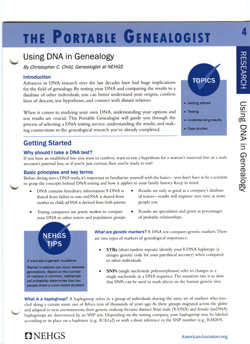I picked up several copies of The Portable Genealogist, published by the New England Historic Genealogical Society, at the SCGS Jamboree this last week that I had not previously seen. One that particularly caught my attention was Using DNA in Genealogy, authored by Christopher C. Child. Christopher recently wrote an absolutely amazing article on how he used DNA & traditional genealogy methodology to establish the identity of the “true” father of one of his relatives. (See: Genetic Surprises at Age 77, page 54-56, American Ancestors Vol 16, no. 2, Spring 2015). Christopher does know his DNA…
This Portable Genealogist is the typical 4 pages in length, folded, and 3-hole punched for inclusion in a binder. The layout is made up of four topics:
- Getting Started
- Testing
- Understanding results
- Case Studies
Under Getting Started, information is given on:
- Why should I take a DNA Test?
- Basic principles and key terms
- What are genetic markers? STRs & SNPs
- What is a haplogroup?
The Testing section deals with what DNA tests are available, and what they might help the researcher discover. The section deals with the Y-DNA, mtDNA, and atDNA tests. Information is then given on selecting a DNA testing agency.
The Understanding the Results section again deals with Y-DNA, mtDNA, and atDNA, the type of results, and how the results are commonly displayed.
Two Case Studies are included.
One case study deals with a series of Y-DNA tests that were done with the goal of confirming the living descendants of Edmund Rice who emigrated from England to Sudbury, Massachusetts in the 17th century. Of 13 volunteers for the project, two were found to have mistakes in their linage, something that may never have been known, but for the Y-DNA testing.
Case study 2 is from the testing done on the remains of Nicholas II, his wife, and their 5 children. DNA testing proved that indeed the Tsar and his family were all murdered, and there were no survivors, as was often rumored.
Five NEHGS TIPS break-out boxes are found within this edition of The Portable Genealogist. They deal with:
- Genetic Mutations
- How Do I test my DNA, or that of deceased relatives?
- Finding the right company for you
- Lessons from case study 1
- Share your results
Finally, The Portable Genealogist – Using DNA in Genealogy gives recommended sources to learn more about DNA research.
I purchased a quantity of The Portable Genealogist – Using DNA in Genealogy for resale by Family Roots Publishing. Cost is $6.95, less FRPC discounts (add $4.50 p&h). Items are shipped by USPS first-class flat mail. Click on the links or illustration to order.
